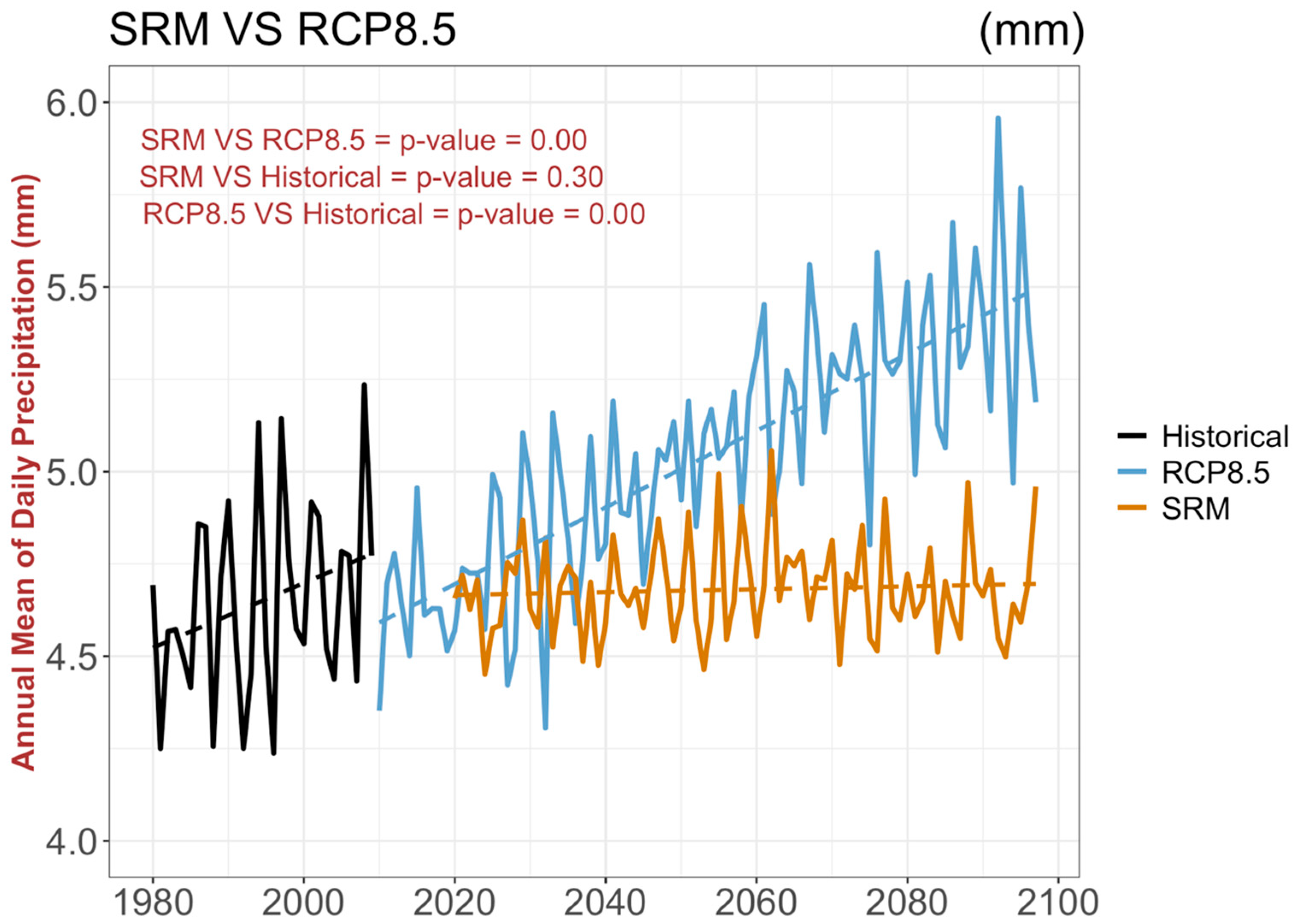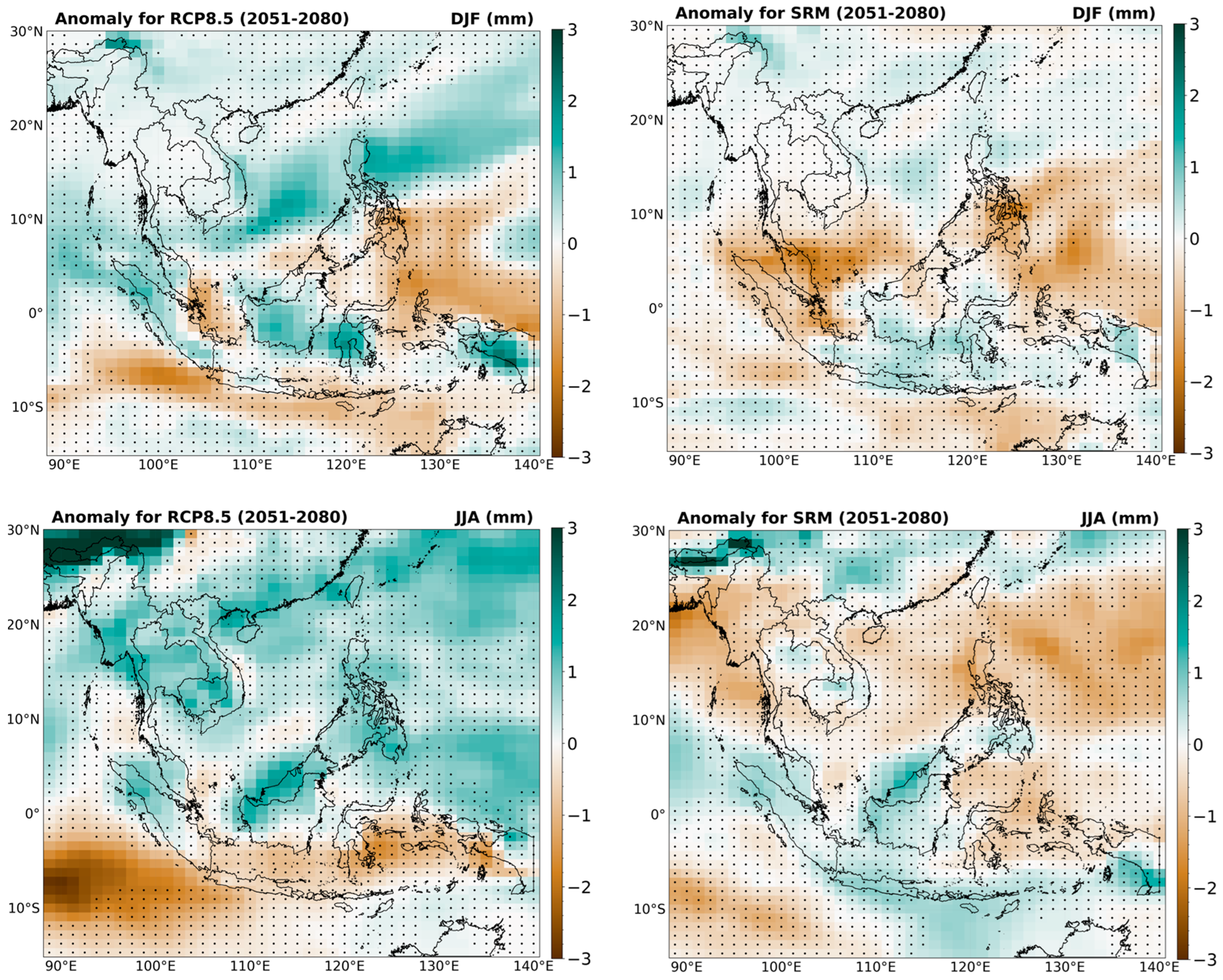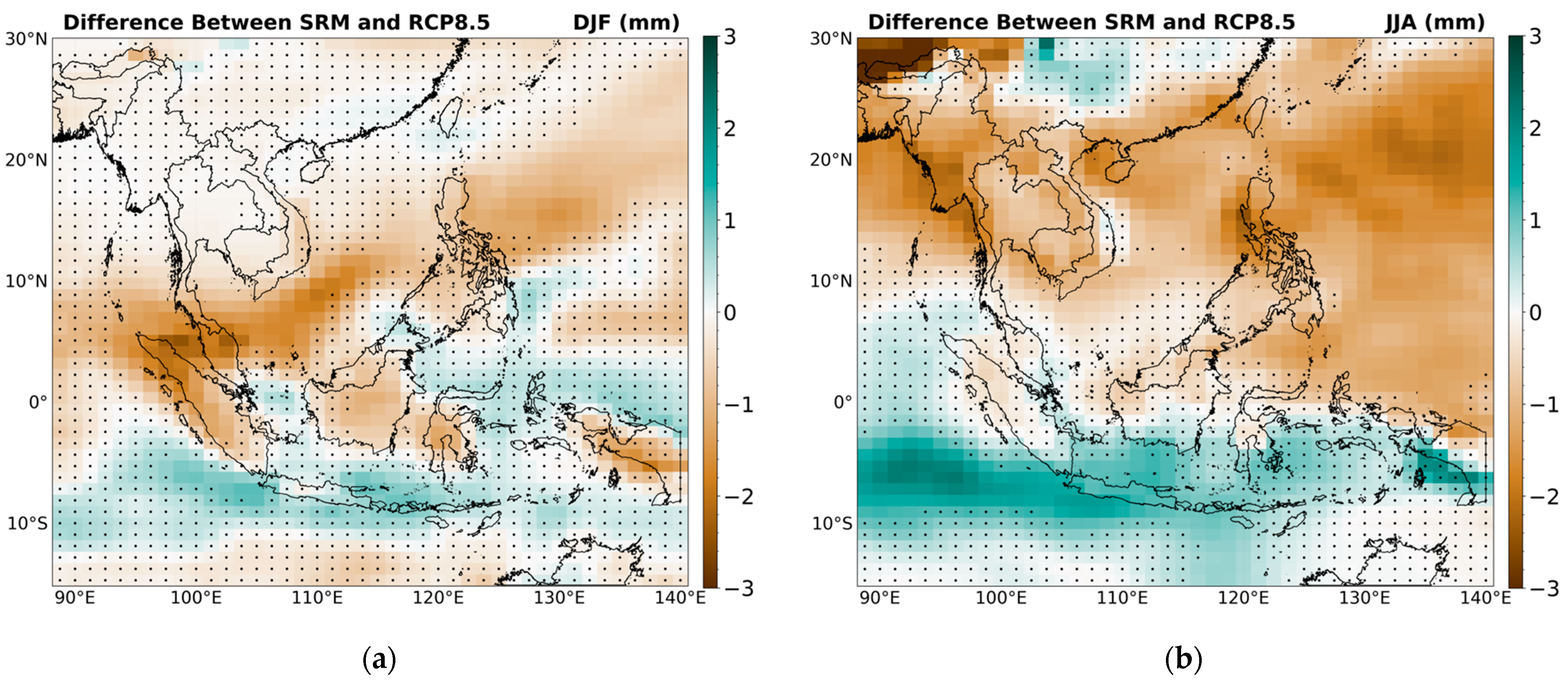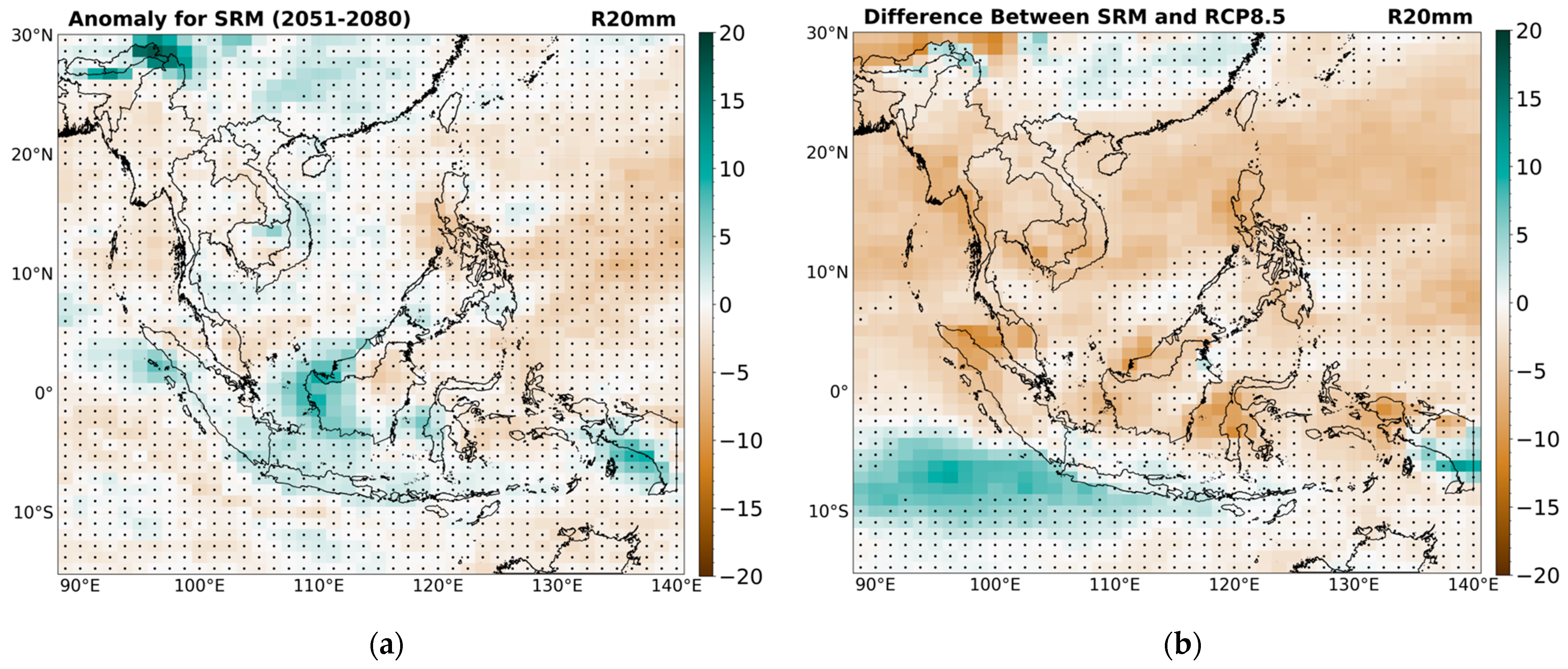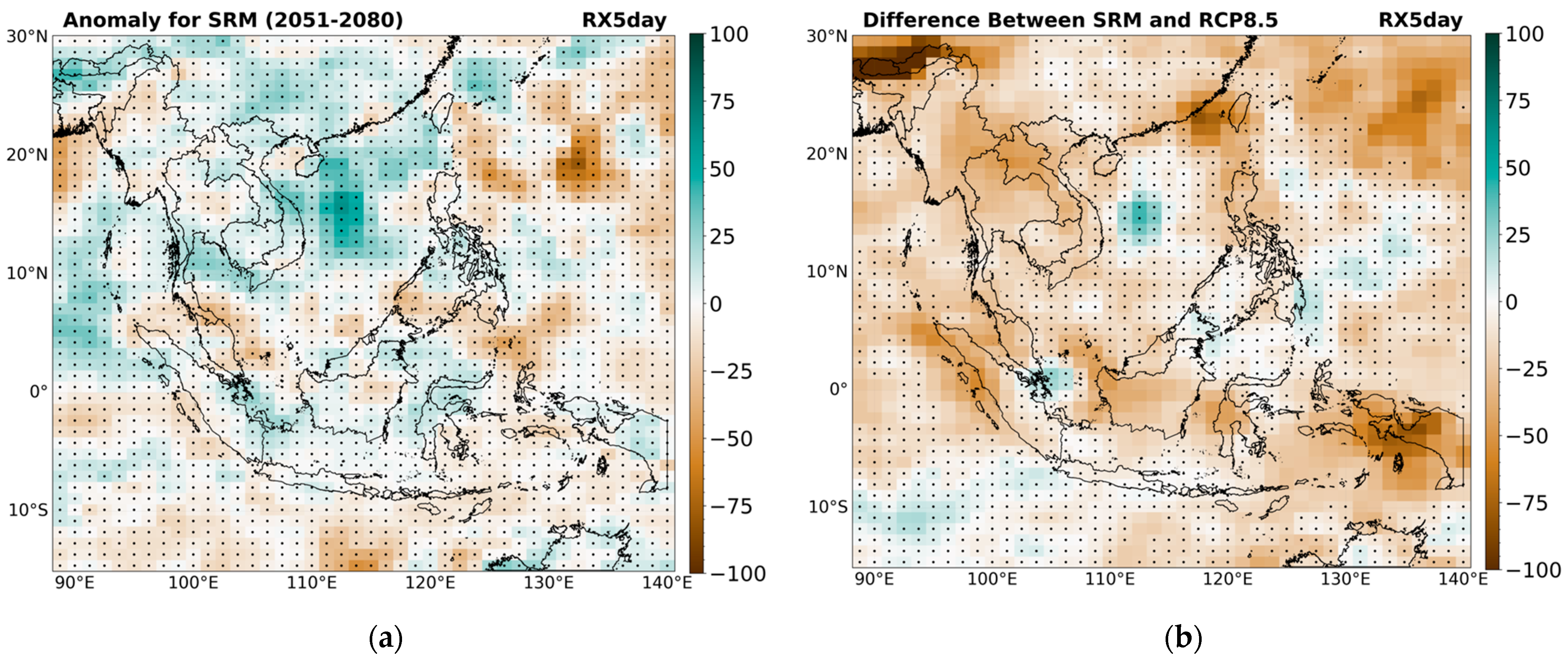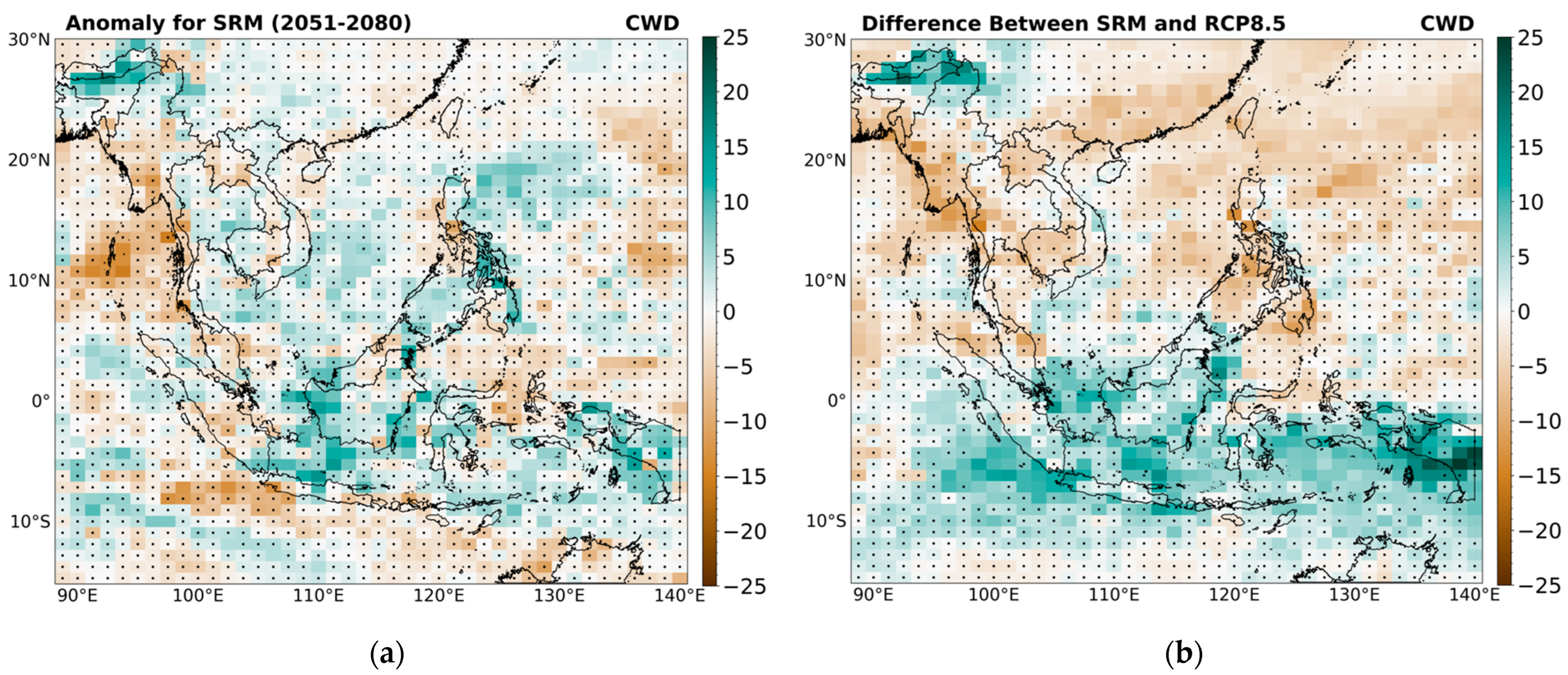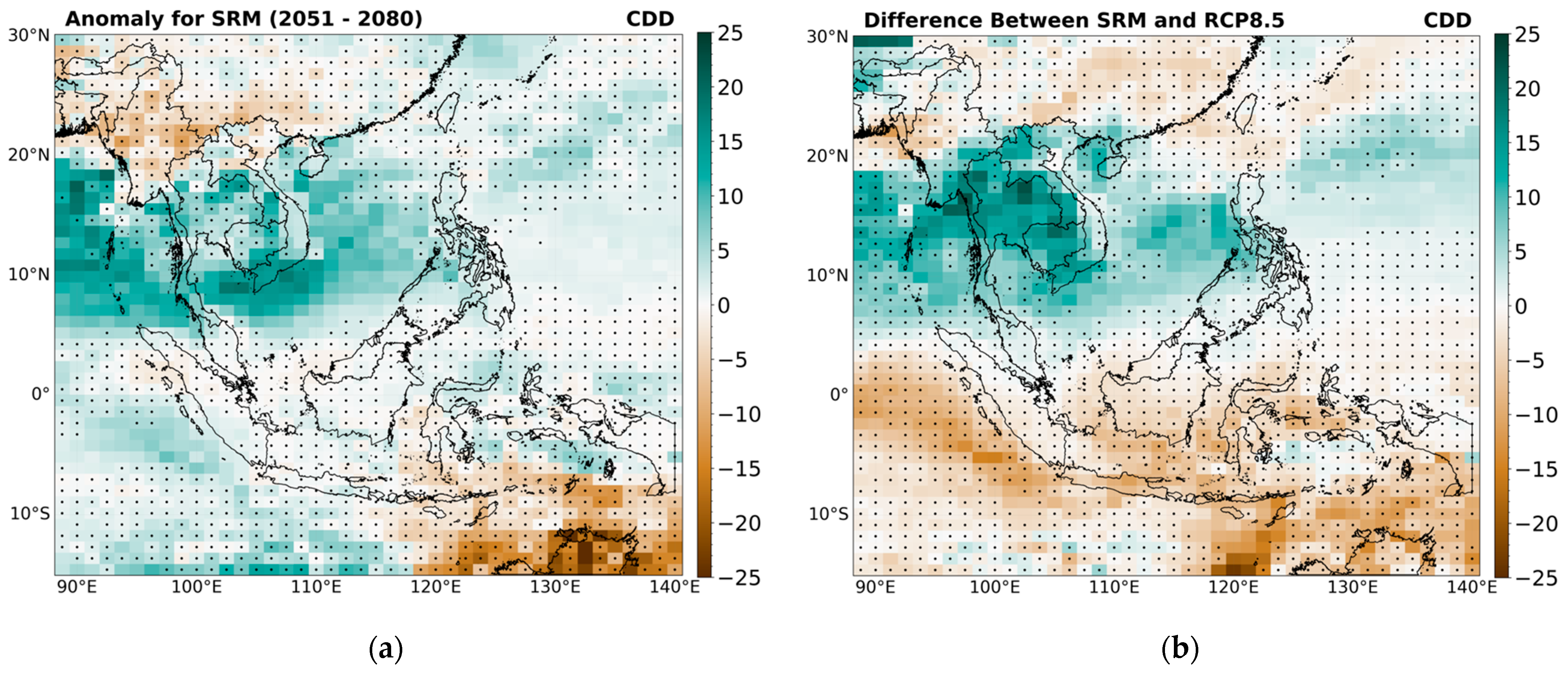1. Introduction
Climate change is one of the most pressing global challenges, driving significant environmental shifts, including rising global temperatures [
1]. Despite international efforts to limit warming to 1.5 °C above pre-industrial levels, greenhouse gas emissions continue to rise, and recent estimates suggest global temperatures had already increased by approximately 1.3 °C as of 2023 [
2]. Without substantial intervention, warming is projected to exceed the Paris Agreement threshold.
Southeast Asia (SEA), with its densely populated coastlines and heavy reliance on agriculture, is particularly vulnerable to these changes. Between 1901 and 2005, surface temperatures in SEA rose by 0.5 to 1.1 °C, and projections suggest the region could surpass the 1.5 °C threshold by the 2030s—well ahead of the Paris Agreement’s 2050 target [
3]. This warming has intensified extreme events such as floods and droughts, threatening public health, agriculture, ecosystems, and infrastructure across the region.
In response to escalating climate risks, technologies such as Carbon Dioxide Removal (CDR) and Solar Radiation Management (SRM) have been proposed. While CDR aims to reduce atmospheric greenhouse gases, SRM seeks to reflect a portion of incoming solar radiation to counteract warming effects [
4,
5]. Among SRM techniques, Stratospheric Aerosol Injection (SAI)—which mimics volcanic cooling by injecting reflective particles into the stratosphere—is the most widely studied. Another method, Marine Cloud Brightening (MCB), enhances cloud reflectivity using sea salt aerosols [
6]. Despite its potential to reduce global temperatures, SRM remains controversial due to uncertainties about long-term effectiveness, uneven regional impacts, and ethical concerns [
7]. Most SRM research has been conducted in developed countries, yet potential deployment could disproportionately affect vulnerable regions like SEA, where ecosystems and societies are highly sensitive to climatic variability.
A growing body of research has examined SRM’s impacts at global and regional scales. For example, Bonou et al. [
8] found modest rainfall reductions from SRM over West Africa, while Patel et al. [
9] noted reductions in precipitation despite temperature mitigation in South Africa. Carlson et al. [
10] showed that SRM could alter malaria transmission, and Ayissi et al. [
11] reported disruptions to coastal upwelling and fisheries. Additional studies have reported effects on glacier melt in the Andes [
12], water storage in the Mediterranean and MENA regions [
13], and changes in extratropical cyclone activity [
14]. These findings underscore the multidimensional and region-specific nature of SRM impacts.
In Southeast Asia, Kuswanto et al. [
15] showed spatial and seasonal variation in temperature response over the Indonesian Maritime Continent. Tan et al. [
16] reported SRM-induced rainfall uncertainty in Malaysia, potentially affecting agriculture and water systems. Additional studies include those by Bandira et al. [
17] and Tan et al. [
18] on Malaysia, and Narenpitak et al. [
19] who analyzed temperature and precipitation over mainland SEA and nearby oceans. Feng et al. [
20] expanded these efforts using GeoMIP6 experiments [
21,
22], finding that G6solar scenarios more consistently reduced extremes, while G6sulfur produced more spatial variability. However, most GeoMIP6 studies rely on multi-model ensembles with varying configurations and limited ensemble sizes, making it difficult to robustly separate forced signals from internal variability—particularly for regional precipitation extremes.
To overcome these limitations, this study uses simulations from the Geoengineering Large Ensemble (GLENS) project [
23], which employs a consistent experimental design using a single model (Community Earth System Model, CESM1) [
24] and dynamically adjusted aerosol injections at four latitudinal bands to maintain global surface temperatures near 2020 levels. This design reduces structural uncertainty and supports controlled assessments of SRM effects. Similar applications of GLENS include analyses by Pinto et al. [
25] for South Africa, Da-Allada et al. [
26] for West Africa, and Cammilloni et al. [
27] for the La Plata Basin. These studies highlight GLENS as a robust framework for regional SRM impact assessment.
Understanding how SAI influences the frequency and intensity of extreme precipitation is critical for evaluating SRM as part of future climate strategies [
28,
29]. Southeast Asia has already experienced increasing trends in precipitation-linked disasters, making it imperative to assess how SRM might alter rainfall regimes. This study uses GLENS simulations to assess SRM’s effects on precipitation extremes in Southeast Asia, using standardized indices—RR1, R20mm, Rx5day, CDD, and CWD. Unlike earlier work focusing mainly on continental areas with GeoMIP6 models, our study explicitly includes maritime nations such as Indonesia, the Philippines, Brunei, and Timor-Leste. This enables a more comprehensive understanding of spatial heterogeneity in SRM responses, with important implications for climate risk assessment, adaptation planning, and regional policy development.
2. Materials and Methods
This study investigates precipitation-related extremes over Southeast Asia using outputs from the Geoengineering Large Ensemble (GLENS) project. GLENS simulations are based on the Community Earth System Model version 1 (CESM1) developed by the National Center for Atmospheric Research (NCAR), United States [
24] that simulates future climate scenarios and is applied to counteract global warming. SRM is implemented through dynamically adjusted stratospheric aerosol injections to stabilize global temperatures at approximately 2020 levels despite rising greenhouse gas concentrations. The GLENS dataset, publicly available through NCAR, provides a consistent experimental framework for assessing the impacts of SRM relative to a high-emissions baseline (RCP8.5), enabling robust evaluation of regional-scale climate responses.
SRM in GLENS is implemented by injecting sulfur dioxide (SO
2) aerosols into the lower stratosphere at four latitudinal bands (30°N, 15°N, 15°S, and 30°S). The injection rates are dynamically adjusted each year to maintain near-constant global surface temperatures at 2020 levels, despite greenhouse gas emissions following the RCP8.5 trajectory. By the end of the century, total annual SO
2 injections reach approximately 50 teragrams (Tg). RCP8.5 serves as the reference scenario, representing a high-emissions, worst-case future pathway, against which the effects and trade-offs of SRM are evaluated [
23,
30].
This study utilizes three ensemble members from GLENS to account for internal climate variability and to enhance the robustness of the analysis. The historical period (1980–2009) and the long-term future projection period (2051–2080) are used for analysis of precipitation anomalies and extremes. This 30-year future window is selected to represent the stabilized climate response to SRM deployment, consistent with prior SAI impact studies. The GLENS simulations have a horizontal resolution of approximately 0.9° latitude × 1.25° longitude, offering adequate detail for regional-scale assessments across Southeast Asia. Precipitation extremes are assessed using standardized indices from the Expert Team on Climate Change Detection and Indices (ETCCDI) [
31]. Specifically, the analysis focuses on the number of wet days (RR1), heavy precipitation days (R20mm), maximum 5-day precipitation (Rx5day), consecutive dry days (CDD), and consecutive wet days (CWD). These indices provide internationally recognized measures of climate variability and extremes, allowing for a consistent evaluation of SRM impacts. A summary of the ETCCDI used is provided in
Table 1, and the study domain for Southeast Asia is shown in
Figure 1.
The climate response to SRM is evaluated by analyzing anomalies, defined as the difference in magnitude between the projection period (2051–2080) and the historical baseline (1980–2009). Additionally, spatial plots comparing SRM and RCP8.5 scenarios are generated to assess whether SRM induces significant responses relative to RCP8.5 alone. Anomalies were calculated separately for SRM and RCP8.5 by subtracting the historical climatology, computed as the ensemble mean of historical simulations, from the simulated future values. Differences between SRM and RCP8.5 were then computed by subtracting the projected RCP8.5 values from the SRM values for each corresponding grid cell and time period. Positive differences indicate that SRM produces higher values of the given index relative to RCP8.5 (e.g., more wet days or greater precipitation), while negative differences indicate lower values under SRM compared to RCP8.5.
3. Results
3.1. Annual Means of Daily Precipitation
We begin the analysis by examining long-term trends in annual mean daily precipitation over Southeast Asia, covering both mainland and maritime regions.
Figure 2 presents time series data for the historical period (1980–2009) and future projections (2010–2100) under the RCP8.5 and SRM scenarios to illustrate long-term trends. While the figure displays the full projection horizon, the primary analysis in this study focuses on the 2051–2080 period to evaluate long-term SRM impacts. During the historical period, annual means of daily precipitation ranged between approximately 4.25 mm and 5.25 mm. Under the RCP8.5 scenario, precipitation exhibits a steady upward trend, with values exceeding 5.5 mm by the end of the century. This increase is likely driven by enhanced surface evaporation and intensified monsoonal circulation in a warmer climate, potentially exacerbating the risk of flooding and hydrological extremes.
Unlike RCP8.5, the SRM scenario shows a markedly different trajectory. While precipitation initially rises slightly after SRM deployment, it subsequently stabilizes at levels comparable to the historical range, remaining consistently lower than in the RCP8.5 pathway. This divergence suggests that SRM may effectively moderate the hydrological intensification associated with continued greenhouse gas emissions, helping to preserve regional rainfall regimes. Statistical comparisons using a Wilcoxon test reveal a significant difference between SRM and RCP8.5 (p = 0.00), as well as between RCP8.5 and the historical period (p = 0.00), confirming the distinct upward shift under high-emission conditions. In contrast, the p-value for SRM versus historical (p = 0.30) indicates no significant difference, reinforcing the interpretation that SRM helps maintain precipitation near historical levels. By constraining precipitation closer to historical norms, SRM could reduce the likelihood of abrupt shifts in water availability that would otherwise pose challenges to agriculture, infrastructure, and water resource management across Southeast Asia.
Figure 3 presents the spatial distribution of projected precipitation anomalies under the RCP8.5 and SRM scenarios for DJF (December–February) and JJA (June–August), relative to the historical baseline (1980–2009). From
Figure 3 onward, stippling indicates regions where the projected changes are not statistically significant at the 95% confidence level based on the Wilcoxon test. Under RCP8.5, the DJF period shows a moderate wetting trend over mainland Southeast Asia, the northern Philippines, and parts of Borneo, likely associated with intensified convection and altered large-scale circulation due to greenhouse gas-induced warming. However, drying anomalies dominate over the southern Maritime Continent, including southern Sumatra and Java, with reductions reaching up to −2 mm/day in some areas. The JJA season under RCP8.5 reveals more notable changes featured by intense drying across Southeast Asia, particularly over Indonesia, Malaysia, and the surrounding ocean basins. These negative anomalies, often exceeding −2 mm/day and locally surpassing −3 mm/day, suggest a substantial weakening of the boreal summer monsoon system, with potential implications for rainfed agriculture, water availability, and hydrological stability. These findings are robust with precedent investigations; McGregor et al. [
32], Villafuerte et al. [
33], Tangang et al. [
34], and Ngo-Duc et al. [
35] further highlight the complex implication of climate change to rainfall regimes across the region.
In comparison, the SRM scenario exhibits a more spatially heterogeneous and moderated response. During DJF, SRM slightly reduces precipitation over parts of mainland Southeast Asia but partially alleviates the drying signal over equatorial regions such as Kalimantan and Sulawesi. However, some regions, such as the southern Philippines and southern Borneo, still experience reduced rainfall, indicating that SRM does not uniformly reverse the effects of warming on precipitation. During JJA, SRM appears to mitigate the most severe drying observed under RCP8.5 in parts of the Maritime Continent, notably in Java, eastern Indonesia, and the Timor Sea region, where anomalies shift closer to neutral or even slightly positive. Nevertheless, precipitation deficits persist over Borneo, the South China Sea, and northern Philippines, reflecting the spatially variable effectiveness of SRM in restoring monsoonal precipitation.
Overall, the results suggest that while SRM has the potential to moderate drying trends, particularly during the summer monsoon, its influence on seasonal precipitation remains complex and uneven. The observed asymmetry in SRM responses between DJF and JJA and across different subregions highlights the nonlinear nature of precipitation changes and the importance of evaluating regional hydrological outcomes in any assessment of climate intervention strategies.
Figure 4 illustrates the spatial differences in seasonal mean precipitation between the SRM and RCP8.5 scenarios during DJF and JJA across Southeast Asia. Positive values indicate increased precipitation under SRM relative to RCP8.5, while negative values reflect drier conditions under SRM. These differences provide insight into the extent to which SRM might counteract the drying effects projected under a high-emissions trajectory.
During DJF, SRM produces a spatially mixed response. Several parts of the Maritime Continent, including southern Indonesia and adjacent oceanic regions, experience further reductions in precipitation compared to RCP8.5, suggesting possible suppression of convection in equatorial latitudes. Conversely, increased precipitation is observed over northern portions of mainland Southeast Asia, including northern Vietnam and Laos, indicating a northward modulation of moisture transport potentially driven by SRM-induced changes in circulation. In JJA, the contrast between SRM and RCP8.5 becomes more pronounced. SRM appears to partially alleviate the intense drying projected under RCP8.5, especially across central and southern regions of the Maritime Continent such as Java, eastern Indonesia, and parts of the Timor Sea. This moderation suggests that SRM may help preserve summer monsoonal rainfall, which is vital for agriculture and water supply. However, SRM does not uniformly offset drying, as negative anomalies persist in parts of mainland Southeast Asia—including Thailand and southern Vietnam—indicating incomplete compensation and persistent precipitation deficits.
The presence of both positive and negative differences across seasons and regions highlights the nonlinear and spatially heterogeneous nature of SRM’s influence on the hydrological cycle. While SRM is designed to stabilize global temperatures, its effects on precipitation are less uniform and more sensitive to regional climatic dynamics. These results reinforce the need for caution in interpreting SRM as a globally consistent solution, and they underscore the importance of conducting region-specific assessments to evaluate potential trade-offs and guide adaptation planning in Southeast Asia.
3.2. Wet Days (RR1)
Figure 5 depicts the spatial anomalies (left panel) and SRM–RCP8.5 differences (right panel) in the annual number of wet days (RR1), defined as days with precipitation ≥1 mm, across Southeast Asia for the period 2051–2080. RR1 is an important index for understanding rainfall frequency, particularly in relation to light-to-moderate precipitation events that sustain soil moisture and support rainfed agriculture.
Under the SRM scenario, a bipolar spatial pattern in RR1 emerges across the region. Several areas across mainland Southeast Asia—including Thailand, Cambodia, southern Vietnam, and parts of the Philippines—exhibit significant decreases in wet-day frequency compared to the historical baseline (1980–2009), with reductions reaching up to 20–30 fewer wet days per year in localized areas. Western Malaysia and portions of western Indonesia, including Sumatra, show similar declines. These reductions suggest either a lengthening of dry spells or increased rainfall intermittency, which could negatively impact agricultural cycles, water supply reliability, and ecosystem functioning in these regions. Conversely, much of eastern Indonesia displays the opposite response. Notable increases in RR1 are found over Java, Bali, East Nusa Tenggara, and Sulawesi, with anomalies exceeding +10 wet days per year in several locations. These changes may reflect the re-establishment of localized moisture convergence zones and convective activity that are more resilient under SRM’s cooling influence—especially over equatorial regions with strong land–sea thermal contrasts. The presence of mountains and windward-facing coastlines in these areas may further enhance orographic rainfall under modestly restored circulation conditions.
The right panel, showing differences between SRM and RCP8.5, reinforces these patterns. A substantial mitigation of drying is observed across Indonesia, particularly over Java and southern Sumatra, where SRM preserves or even increases wet-day frequency relative to the RCP8.5 baseline. In contrast, the Philippines stands out as a region with the most severe decrease in RR1 under SRM compared to RCP8.5—an outcome that raises potential concerns about intensifying drought risks despite the overall cooling benefits of SRM.
This heterogeneity highlights that SRM does not uniformly restore rainfall frequency and may induce shifts in precipitation distribution, especially in regions affected by complex topography, localized convection, or monsoon-modulated regimes. As wet-day frequency is critical for sustaining agricultural livelihoods and ecological balance in Southeast Asia, these results underscore the importance of incorporating regional-scale hydrological assessments into any evaluation of SRM as a climate intervention strategy.
3.3. Very Heavy Precipitation Days (R20mm)
Figure 6 shows spatial anomalies (left panel) and differences between SRM and RCP8.5 scenarios (right panel) in the annual frequency of very heavy precipitation days (R20mm), defined as days with daily rainfall exceeding 20 mm, for the period 2051–2080. This index reflects the intensity and frequency of heavy rainfall events that can drive flash flooding and erosion.
Under the SRM scenario, the left panel reveals a generally modest change in R20mm across much of Southeast Asia, with anomalies ranging from −5 to +5 days per year compared to the historical baseline. However, distinct spatial variations are evident. The majority of mainland Southeast Asia—including central Vietnam, Laos, and northeastern Thailand—show a decrease in the frequency of heavy precipitation events, with reductions of 1–5 days annually. These reductions suggest a suppression of convective activity, potentially linked to SRM-induced changes in upper-level stability and lower moisture availability. Stratospheric aerosol injections tend to cool the surface more than the upper troposphere, increasing static atmospheric stability and inhibiting vertical motion. Additionally, the reduction in solar radiation can lead to lower surface evaporation and reduced boundary-layer moisture, especially during peak convective seasons. By contrast, the right panel shows that SRM increases the frequency of R20mm events in certain parts of the Maritime Continent relative to RCP8.5. Notably, Java, southern Sumatra, parts of Kalimantan, and Papua exhibit increases of 3–5 days per year. This enhancement may reflect persistent moisture convergence interacting with existing orographic features. In mountainous regions such as Java and Papua, even modest increases in low-level moisture under SRM may enhance orographic precipitation, despite the topography itself remaining unchanged. These areas—characterized by complex terrain and strong mesoscale circulation—appear more resilient in maintaining conditions conducive to heavy rainfall under SRM.
The overall pattern indicates that SRM tends to slightly suppress extreme precipitation frequency across most of the region compared to RCP8.5, yet local enhancements in some Indonesian subregions emphasize that SRM’s influence is not uniformly dampening. These findings point to the nuanced interaction between aerosol-driven radiative forcing and regional dynamics such as monsoon behavior, land–sea contrast, and topographic modulation. Importantly, the contrast between suppression in the continental regions and localized enhancement in parts of Indonesia highlights the need for high-resolution, region-specific evaluations when assessing SRM’s hydrological impacts.
3.4. Highest Precipitation Amounts in 5 Consecutive Days (RX5day)
The spatial anomalies and SRM–RCP8.5 differences in Rx5day are depicted in
Figure 7, representing the annual maximum total precipitation accumulated over any five consecutive days across Southeast Asia for the period 2051–2080. This index is particularly important for assessing flood risks and the intensity of prolonged heavy rainfall events.
Under SRM, Rx5day exhibits a spatially heterogeneous response across the region. Compared to the historical baseline, both increases and decreases in multi-day precipitation extremes are observed, with anomalies ranging from −75 mm to +75 mm. However, when contrasted directly with RCP8.5 (right panel), SRM leads to a widespread reduction in Rx5day in several key regions—including central and northern Vietnam, Peninsular Malaysia, Sumatra, Kalimantan, Sulawesi, and parts of Papua—where decreases reach up to 30–50 mm. These reductions suggest that SRM may help mitigate the intensity of extreme storm events and lower the risk of flash flooding in areas typically vulnerable to heavy rainfall. Meanwhile, certain locations such as Thailand, southern Malaysia (including Johor Bahru), and Java show little to no change in Rx5day under SRM compared to RCP8.5. This persistence of multi-day extreme precipitation could be linked to regional factors such as localized moisture convergence, mesoscale convective systems, or orographic uplift that are less influenced by global temperature regulation through SRM.
The mixed nature of the Rx5day response emphasizes the regionally variable effectiveness of SRM in modulating extreme precipitation events. While SRM appears to reduce precipitation extremes in many coastal and island regions, it may be insufficient to suppress extremes in areas where topography and local dynamics play a dominant role.
3.5. Consecutive Wet Days (CWD)
The spatial anomalies and SRM–RCP8.5 differences in Consecutive Wet Days (CWD) are illustrated in
Figure 8, representing changes in the duration of wet spells across Southeast Asia during the period 2051–2080.
Under the SRM scenario, the anomaly map (left panel) reveals a mixed pattern across the region. Mainland Southeast Asia, particularly parts of Vietnam, Thailand, Cambodia, and northern Malaysia, exhibits a notable reduction in CWD by up to 10–15 days compared to the historical baseline. This suggests a shortening of wet spell duration under SRM, which may imply drier conditions during the wet season or more intermittent rainfall events. Meanwhile, maritime Southeast Asia shows a different pattern. In eastern Indonesia—including Sulawesi, Papua, and parts of Borneo—SRM tends to increase the duration of consecutive wet days by 5 to 15 days. This could potentially enhance seasonal rainfall continuity in these equatorial regions, supporting agricultural activities but also raising concerns about localized flood risks if wet periods are excessively prolonged.
The SRM–RCP8.5 difference map (right panel) further highlights the contrasting regional responses. Compared to RCP8.5, SRM effectively mitigates the reduction in CWD in much of maritime Southeast Asia, particularly over Indonesia, where the positive differences suggest a restoration or even slight extension of wet spell durations. Conversely, mainland regions such as Vietnam, Thailand, and the Philippines continue to show a reduction in CWD relative to RCP8.5, indicating that SRM may not fully counteract the drying trends projected under high-emission pathways for these areas.
3.6. Consecutive Dry Days (CDD)
Figure 9 presents the spatial anomalies and SRM–RCP8.5 differences in CDD (Consecutive Dry Days), which refers to the maximum number of consecutive days in a year with rainfall below 1 mm. This index is crucial for identifying prolonged dry spells that can impact agriculture, water availability, and drought risk.
The results show a regionally differentiated response to SRM across Southeast Asia. In Vietnam and Thailand, SRM is projected to significantly lengthen dry spells, with anomalies reaching up to 15 days longer than the historical period, and 5–15 days longer than under RCP8.5. This suggests that, despite the overall cooling effect of SRM, it may lead to drier conditions in continental regions, potentially due to a weakening of monsoonal moisture transport or suppressed convective activity. The implications for these areas are serious, as extended dry spells can strain irrigation systems, increase the risk of agricultural drought, and reduce soil moisture critical for crops such as rice and maize. In contrast, parts of Indonesia, especially Java and Sulawesi, exhibit a shortening of CDD under SRM. Compared to both the historical baseline and RCP8.5, these regions show reductions in dry spell duration by up to 10 days, which is consistent with the increase in wet days (RR1) previously discussed. This likely reflects enhanced rainfall frequency associated with SRM-induced shifts in local circulation or cloud microphysics in equatorial maritime zones. Such a pattern could benefit rainfed agriculture by improving water availability during dry seasons and reducing pressure on irrigation. The SRM–RCP8.5 difference map emphasizes that continental and maritime Southeast Asia respond differently to SRM. While mainland regions become drier, maritime zones may become wetter, underscoring the heterogeneous and sometimes opposing effects of SRM interventions across climate zones.
4. Discussion
This study offers a comprehensive assessment of the impacts of SRM through SAI on precipitation-related extremes across Southeast Asia, using ensemble simulations from the GLENS project. The results build upon and extend previous research, particularly Feng et al. [
20] and Narenpitak et al. [
19], by providing a more detailed, regionally focused analysis based on standardized ETCCDI precipitation indices.
Consistent with prior studies, our findings show that SRM can moderate some of the hydrological intensifications projected under high-emission scenarios. However, the precipitation response is highly spatially heterogeneous. SRM tends to reduce wet-day frequency (RR1) and the maximum 5-day precipitation totals (Rx5day) across much of mainland Southeast Asia and parts of the Maritime Continent, broadly aligning with the drying trends reported by Narenpitak et al. [
19] for the G6sulfur and G6solar scenarios. Yet, unlike Narenpitak et al. [
19], who focused primarily on mean seasonal precipitation changes, our results highlight localized patterns of recovery, especially over Indonesia. Regions such as Java, Sulawesi, and Papua exhibit increases in wet-day frequency and very heavy precipitation days (R20mm) under SRM. These finer spatial details, enabled by the consistent modeling approach and larger ensemble spread in GLENS, reveal that SRM’s influence on precipitation extremes is far more complex than a simple uniform drying or wetting trend.
Comparisons with Feng et al. [
20] further emphasize important differences. Feng et al. [
20] noted that the G6solar scenario generally delivered more consistent reductions in extremes, while G6sulfur showed complex and sometimes counterintuitive regional responses. In contrast, our analysis of dynamically adjusted sulfur injection in GLENS suggests that adaptive aerosol management strategies can reduce some of the chaotic variability found in uniform sulfur experiments, although substantial regional heterogeneity remains. The persistence of both positive and negative precipitation anomalies under SRM reinforces the view that aerosol-based interventions cannot be expected to uniformly correct climate imbalances.
Several key regional differences emerge from our analysis. The Philippines stands out as a hotspot of persistent vulnerability, where SRM is projected to decrease wet-day frequency and lengthen dry spells (CDD), potentially worsening drought risks even under cooler temperatures. This critical finding was not explicitly emphasized in Feng et al. [
20] or Narenpitak et al. [
19], underscoring the importance of detailed regional analysis. Meanwhile, parts of Indonesia, particularly Java, southern Sumatra, and Papua, show resilience under SRM, with increases in rainfall frequency and intensity relative to RCP8.5. These positive signals suggest that SRM might support moisture recycling and convective processes in some equatorial zones, although the benefits are not uniform across all islands. Conversely, regions like Vietnam, Thailand, and Cambodia continue to face reduced precipitation and longer dry seasons, mirroring drying patterns highlighted by Narenpitak et al. [
19] but with greater spatial resolution. The implications of these spatial patterns for agriculture, water resources, and disaster risk management are profound. Reductions in wet-day frequency and increases in consecutive dry days could significantly challenge rainfed agriculture, particularly in mainland Southeast Asia and the Philippines, where regular rainfall is essential for food security. Although SRM may lower flood risk in some coastal and lowland areas by reducing Rx5day values, its ability to mitigate extreme rainfall remains uneven. Persistent multi-day extremes in Java and southern Malaysia, for instance, suggest that local orographic effects and mesoscale convective systems may be less sensitive to global cooling induced by SRM.
The differences between our findings and those of Feng et al. [
20] and Narenpitak et al. [
19] also highlight methodological factors. GLENS’s consistent model physics, dynamic aerosol injection across four latitudes, and relatively larger ensemble size help minimize inter-model uncertainty and enable clearer attribution of changes to SRM forcing. On the other hand, the GeoMIP6-based studies relied on multiple models with different injection implementations, introducing structural variability that complicates interpretation of regional impacts. Our use of standardized ETCCDI further strengthens the connection between precipitation changes and real-world hazard indicators.
A salient feature of our findings is the pronounced spatial heterogeneity in SRM-induced precipitation changes across Southeast Asia, often expressed as a dipole pattern: drying over equatorial regions (e.g., Indonesia) and increased precipitation in some mid-latitude areas (e.g., mainland Southeast Asia). This pattern likely results from SRM-induced perturbations to large-scale atmospheric circulation, driven by the latitudinal distribution of aerosol injections in the GLENS experiment (30° N, 15° N, 15° S, and 30° S). These injections modify both meridional and zonal temperature gradients, which in turn affect the strength and position of the Hadley and Walker circulations and shift the Intertropical Convergence Zone (ITCZ). These changes can suppress convection in tropical regions while enhancing moisture convergence at higher latitudes. Additionally, the complex interplay with local climatic features—such as topography, land–sea contrast, and monsoon variability—further amplifies spatial differences in precipitation response. Similar dipole structures have been identified in prior SRM studies (e.g., Tilmes et al. [
23], Jones et al. [
28]), reinforcing the view that SRM’s hydrological impacts are highly nonlinear and region-specific. Although a full dynamical decomposition is beyond the scope of this study, future work should incorporate moisture budget analysis and circulation diagnostics to further elucidate these mechanisms.
Despite these contributions, some limitations must be acknowledged. Our analysis is based on only three ensemble members from GLENS which may underestimate the full range of internal variability, especially for extremes. Moreover, the horizontal resolution of GLENS (~1° × 1.25°) may not adequately capture localized convective processes, particularly over mountainous or archipelagic areas. High-resolution downscaling studies are needed to refine these projections and assess sector-specific vulnerabilities. Overall, this study reinforces the growing recognition that SRM would introduce complex trade-offs rather than uniformly correcting climate risks. While SRM may mitigate extreme heat and moderate some hydrological extremes, it would also redistribute risks, creating new vulnerabilities in certain regions. For Southeast Asia, a region with diverse climatic zones, strong dependence on seasonal rainfall, and high socio-economic sensitivity, such redistribution could have profound consequences. Policymakers and stakeholders must recognize that SRM is not a simple or risk-free solution, and any consideration of its deployment must be accompanied by rigorous regional impact assessments, stakeholder engagement, and careful governance structures that prioritize climate justice and equity.
5. Conclusions
This study provides a comprehensive evaluation of how SAI as a form of SRM could alter precipitation-related extremes across Southeast Asia using ensemble outputs from GLENS. Our results show that SRM can partially mitigate some of the drying and extreme precipitation trends projected under RCP8.5, particularly during the boreal summer monsoon season. However, SRM’s effects are highly spatially heterogeneous. While parts of the Maritime Continent, including Java, Sulawesi, and Papua, may experience a recovery in rainfall frequency and reductions in extreme rainfall intensity, other areas—most notably the Philippines, Vietnam, and Thailand—face persistent reductions in wet days and longer dry spells, potentially exacerbating drought risks despite global temperature stabilization.
In comparison to earlier work by Feng et al. [
20] and Narenpitak et al. [
19], this study adds a more regionally nuanced perspective by focusing specifically on precipitation extremes, employing dynamically controlled aerosol injection simulations, and covering the full breadth of both mainland and maritime Southeast Asia. These results reveal that SRM, even under dynamically managed deployment strategies, introduces significant regional trade-offs and cannot be expected to deliver uniform benefits across vulnerable regions. The findings reinforce the need for caution in considering SRM as a climate intervention strategy. While it may offer partial relief from extreme warming, it also redistributes hydrological risks, which could undermine food security, water resources, and disaster resilience in sensitive regions like Southeast Asia. Any future evaluation or potential deployment of SRM must be accompanied by fine-resolution impact assessments, robust governance frameworks, and inclusive international dialogs that account for the uneven distribution of risks and benefits.
Future research should prioritize high-resolution downscaling of SRM simulations, integration of sectoral impact models, and the exploration of compound and cascading extreme events. Engaging with local policymakers and communities will also be crucial to ensure that any climate interventions pursued are informed by equitable, transparent, and scientifically robust assessments.

